




Welcome back Coasties! I hope you’ve had a relaxing start to the New Year. For my family, we’ve enjoyed a decent break. January was a long, luxurious pause. Slow days, no school, and beach hangs meant the holiday feel lingered and left us refreshed.
With February upon us, it’s time to start looking forward. In this month’s issue we look at what to do when you receive an unexpected inheritance, (pg 8), we take a deep dive into what your face can reveal about your health, (pg 14) and if you think you can’t do push ups, think again - we take you through exactly how to work up to push up success (pg. 18).
Thank you for joining us for another year, may we all approach it with optimism and enthusiasm – here’s to a great 2025, Coasties!
Love and light always =)
Art Director/Editor
Tanzie Carpenter tanzie@onthecoastpublications.com.au
Production Luke Carpenter luke@onthecoastpublications.com.au
Editor Jessica Sanford editor@onthecoastpublications.com.au
Publisher
Tanzie Carpenter / 0414 611 851 Luke Carpenter / 0405 449 339 trading as On the Coast Publications ABN 52 212 212 482 PO Box 3251, Bateau Bay NSW 2261
For advertising enquiries advertising@onthecoastpublications.com.au
For article contribution enquiries tanzie@onthecoastpublications.com.au
Imagery freepik.com
Contributors
Advertisers
4 Colour Confidence – How to choose the right hue for you!

7 Adam Crouch MP Member for Terrigal: Back to School
8 Building a better future –What to do when you receive an (unexpected) inheritance
10 Relocating with children in Australia: Key considerations for parents
12 Understanding Perimenopause & Menopause
14 What your face reveals about your internal health: from an Eastern perspective
16 OMG, there are two of them! Navigating ‘twinning’
18 Up, up and away –How to gain strength and master the push up
19 New Year, New Plans: Arrangements for minor children in your will
responsibility
20 Softening your anger, control and perfectionism
22 Love your bod!
Sam Woods, Jordi Woods, Simon Tarrant, Mia Eddy, Dr Georgia Page, Zoe Papadatos, Selina Chapman, Louise Hurley, Carin Clegg, Alita Blanchard & Jacqui Bilson. onthecoastpublications.com.au Read our previous articles at onthecoastfamilies.com.au
@onthecoastfamilies proudly supported by
BY SAM & JORDI WOODS
HOW TO CHOOSE THE RIGHT HUE FOR YOU!”
Before we even get into this article we want to send a little word of warning…of late we have been inundated with clients coming to us after trying many online colour analysis “services” that are not personal or conducted by a professional but rather from generic information, often is AI generated.
Now if this works for you, and you are happy with the results, then go for it! However, the feedback we have been receiving (in abundance) is clients are left feeling more confused or just not resonating with the information they are given.
Naturally, we will always suggest seeing a professional face–to–face or using an online system that is truly personal (human–to–human) and not one that is conducted by a computer, or AI, but one where you can be in conversation with someone that is looking at your photos and comments and personally customising your colour palette to work for you.
However, regardless of how you wish to learn about personal “colour confidence” the points outlined in this article must be considered when opting for a correct colour palette and how an individual chooses to wear their best hues, tones and shades.
Colour plays a vital part in the success of our image and truly is the key that unlocks our inner beauty and gives us the confidence to feel comfortable in our own skin. When we surround ourselves with clothing, accessories, hair colour and makeup in hues and tones that flatter and compliment our complexion, hair and eyes, we enhance our natural beauty. However, when we surround ourselves with colours and tones that clash with our complexion, we detract and “fight” our natural beauty.
The power colour possesses is so intense it has the ability to:
create a positive or negative energy
affect our emotions
alter our mood
attract or detract from our natural beauty
affect our confidence levels
These reasons make colour the most influential component of our style. Therefore, if we wish to look and feel our best we must surround ourselves in the correct colours that compliment our appearance, harmonise with our personality and define our style.
The Science – determined by the things we can not change, like our skin, eyes and their clarity to each other.
Step 1
The undertone of a complexion must be determined. Is the skin warm with yellow, golden or ivory undertones and a cool overtone or vice versa. Or is the skin warm or cool all over?
Step 2
The eye colour, both the flecks of colours in the pupil and the clarity of the whites of the eye ball must also be taken into consideration when determining the tone, strength and vibrancy of a person’s colour palette. Are they more yellow/white or blue/white?
Step 3
The relation of skin tone to features


Colour plays a vital part in the success of our image and truly is the key that unlocks our inner beauty and gives us the confidence to feel comfortable in our own skin
(hair colour can only be considered if it is natural in colour). Are these components contrasting, muted or clear?
The Personality – must be considered as this will determine how we relate to colour.
When colour coding, your personality, style and preferences must be taken into account as everyone is different and how you wish to wear colours can be different too.
Do you like dramatic, vibrant hues or do you feel more comfortable in pretty, delicate shades? Do clear colours make your eyes sparkle or do muted, deep shades intensify your eye colour?
Another consideration is that colour trends come and go so always be sure
to wear colours that suit you. It doesn’t matter how popular a colour may be or how much you like it, if it doesn’t like you it will be hard work.



The autumn season palette is warm, earthy and fiery! Autumns need rich shades that intensify their warmth even when wearing lighter colours. Their colours are best worn tone on tone or in low contrast.



The winter season colour palette is clear, bright and cool. Pastels must be icy and never dusty. Winters are radiant in rich, dark, blue–based colours, jewel tones and icy pastels.
Please Note: The below colours are only an indication of the season’s colour strength and tone not the only shades that these seasons can wear.



The summer season palette is cool, delicate and softly vibrant. Colours range from chalky pastels and muted tones to medium bright and soft, clear colours worn in low contrast.



The spring season palette is warm and energetic. Springs need vibrant shades that intensify their warmth even when wearing pastels and lighter colours. They are radiant when they wear their colours in contrast.
If we wish to look and feel our best we must surround ourselves in the correct colours that compliment our appearance, harmonise with our personality and define our style
So, what colour season do you feel resonates with you?
Happy colour coding! Sam & Jordi xx

Understanding styling and fashion is one thing. Having a super natural flair for making everyday people look incredible is another. Once you’ve met Sam and Jordi Woods, it’s hard not to catch their infectious passion for dressing to match your own lifestyle, personality and charisma. Through their consultancy ‘Vibrant Concepts’, Sam and Jordi have transformed the lives of thousands. Let Sam and Jordi show you how to look and feel fabulous everyday at their Style Studio in Erina – learn the art of illusion dressing, colour matching, styling, translating fashion trends and savvy shopping with their unique VC Signature Styling Systems and services that are truly personal and really work! To contact Vibrant Concepts phone 0425 221 676


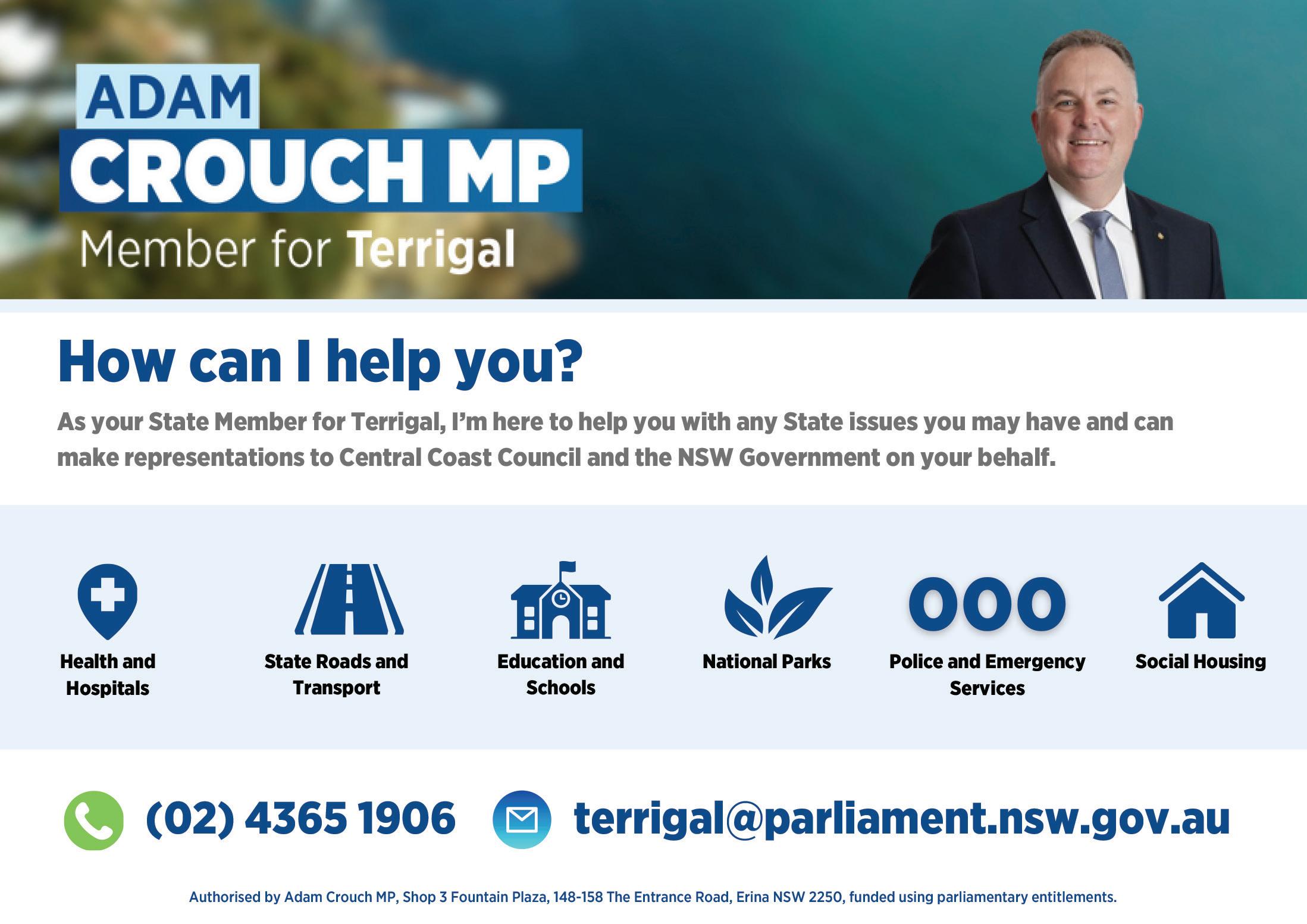


It’s that time of the year where school zones are in force and there’s a little more traffic on the road. That can mean only one thing – it’s back to school time! This time can often be a crazy time for parents, so it’s always important to be aware that help is available.
Unfortunately, parents are more under the pump than ever. One of the biggest concerns I am hearing out in the community is the issue of cost–of–living and how it’s impacting parents preparing to send their children back to school.
On average, parents are expected to pay $684 per child on back–to–school costs this year. This includes essentials like uniforms, stationery, textbooks, and technology – items that are not luxuries but necessities for their children’s education.
For families with multiple children, these expenses can quickly sky–rocket, which places immense pressure on household budgets already stretched thin by the rising cost of groceries, rent, and utilities.
Nearly 36% of parents will need to use credit cards or buy now pay later services just to afford these expenses, a massive increase over the past year. This will only push families deeper into debt and place massive strain on family finances.
Even worse, parents will end up having to make difficult choices – paying their bills or ensuring their children have the tools they need to get ahead at school. It shouldn’t be like this.
Under the former Liberal–National Government, parents received 3x $50 Back–to–School vouchers which provided $150 of much needed assistance for families purchasing essential school supplies like uniforms, stationery and books.
The program was immensely popular, with over 3.5 million vouchers redeemed in 2023 by NSW families, most of which were claimed in lower socio–economic and regional electorates.
Nearly
36% of parents will need to use credit cards or buy now pay later services just to afford these expenses, a massive increase over the past year
Despite this, the Minns Government axed the program, calling it a cash splash, something which is both arrogant and out of touch with the community.
Families are doing it tough. The Minns Government needs to deliver on cost–of–living measures and support local families.
These vouchers were an important cost–of–living measure that families relied on, and we need them back.
CONTACT ADAM Always available to meet with you to discuss your concerns. Shop 3 Fountain Plaza, 148–158 The Entrance Road, Erina, NSW Australia 2250 (02) 4365 1906 | terrigal@parliament.nsw.gov.au Adam Crouch MP adamcrouchmp
BY SIMON TARRANT, PRIVATE, CLIENT ADVISER AT MORGANS FINANCIAL LIMITED

The sky–rocketing property market in Australia has created an unforeseen financial phenomenon. A growing number of families are receiving unexpected inheritances due to the significant increase in property values over the past few decades. For many Australians, these inheritances represent a transformative financial opportunity. However, without the right planning and advice, this sudden windfall can also bring challenges.
If you’ve recently inherited a property or a large sum of money, it’s natural to feel a mix of emotions – gratitude, responsibility, and even confusion about what to do next. Taking a strategic approach can ensure you make the most of this gift for your family’s future. Here are five critical steps beneficiaries should consider.
1. Pause and reflect
It can be tempting to make immediate decisions when receiving an inheritance, whether it’s paying off debt, buying a new car, or splurging on a family holiday. However, it’s essential to take a step back and evaluate your
financial position. Consider the values and intentions of the person who left you this gift and how you can use it to honour their legacy. Avoid making rushed decisions until you have a clear plan.
2. Engage a financial adviser
Navigating an inheritance can be overwhelming, especially when it involves substantial sums or property assets. Consulting a qualified financial adviser can help you make informed decisions aligned with your long–term goals. Whether it’s creating a strategy for investing, reducing debt, or planning for your children’s future, professional
advice ensures your inheritance works harder for you.
A financial adviser can also guide you through the tax implications of your inheritance. While inheritances are generally not taxed in Australia, capital gains tax (CGT) may apply if you sell an inherited property, and proper structuring can help minimise these costs.
3. Assess immediate financial priorities
An inheritance can provide an opportunity to address pressing financial concerns, such as high–interest debt or an underfunded emergency

Consider the values and intentions of the person who left you this gift and how you can use it to honour their legacy. Avoid making rushed decisions until you have a clear plan
savings account. Prioritising financial stability before making discretionary purchases can lay the groundwork for long–term security. A financial adviser can help identify which debts or obligations should take precedence.
4. Invest for the future
For many young families, an inheritance can serve as a springboard to future prosperity. Investing part of the funds in a diversified portfolio can create long–
term growth and income. Alternatively, contributing to your superannuation or purchasing an investment property can bolster your retirement planning and financial resilience. Align your investment choices with your goals, whether it’s financial independence, funding your children’s education, or achieving other family milestones.
5. Plan for generational wealth
Receiving an inheritance can be an opportunity to think about your own family’s financial future. Consider how you can set up structures, such as family trusts or updated wills, to pass on wealth efficiently to the next generation. Engaging in estate planning ensures your loved ones are supported and prepared to handle any future windfalls responsibly.
Making the most of an inheritance
While an inheritance is often referred to as a “windfall,” managing it responsibly
If you would like to discuss your family’s financial strategy, please contact Simon at simon.tarrant@morgans.com.au or via (02) 4325 0884. Morgans Financial Limited
Simon Tarrant (AR: 001270872) is a Private Client Adviser at Morgans Financial
(AFSL 235410 /ABN 49 010 669 726). Simon is passionate about creating quality financial strategies that are tailored and customised to a clients’ lifestyle, financial goals and risk profile. Disclaimer: While every care has been taken, Morgans Financial Limited makes no representations as to the accuracy or completeness of the contents. The information is of a general nature only and has been prepared without consideration of your individual objectives, financial situation or needs. Before making any decisions, you should consider the appropriateness for your personal investment objectives, financial situation or individual needs. We recommend you see a financial adviser, registered tax agent or legal adviser before making any decisions based on this information.
requires careful thought and expertise. A financial adviser brings clarity and structure to this process, helping you align your decisions with your goals and values. By taking a considered approach, you can transform a one–time gift into a legacy of financial security and opportunity for your family.


BY MIA EDDY, PARALEGAL, ORBELL FAMILY LAWYERS
Relocating with children after a separation or divorce is a common issue for separated parents and often a complex and emotionally charged decision. Under Australian family law, it is critical to approach this issue carefully to avoid legal and emotional complications. Mia Eddy, Paralegal at Orbell Family Lawyers explores the essential considerations and steps involved in relocation cases.
There are many reasons why a parent might want to relocate to a different area after separation. This could include wanting to move nearer to family/ support, wanting to move with a new partner who might live in a different location, or moving for a job/employment opportunity.
When relocation is considered in a family law context, it is the relocation of the child (and not the parent) that is the key consideration and whether the relocation is in the child’s best interests. Relocation usually refers to cases where it is proposed for the child to relocate away from where they live to another town, state or even country and where this would require changes to any existing parenting arrangements.
Whether a parent will be able to relocate a child’s residence will depend on many factors and involves considering the existing parenting arrangements, whether there are any Orders/agreements in place that would prevent the relocation (without the other parent’s consent or permission from the Court), how the relocation would impact the child’s time and relationship with the other parent and whether the relocation is in the best interests of the child.
If an international relocation is proposed, this also involves consideration
of international family law and will often require family lawyers from Australia and the other country to work together to have binding parenting arrangements in place in both jurisdictions.
If there are existing Orders in place and the proposed relocation would result in an inability to comply with those Orders (including if the time could not occur, school needed to be changed, the changeover location was no longer possible) then the relocation will not be possible without obtaining the other parent’s consent or permission from the Court.
If a parent relocates and this results in a contravention of existing Orders, this can have serious consequences, including an Order for costs against that parent and the risk that the Court will not permit the relocation.
The first step for any parent wanting to change Orders (including for relocation) is to try to negotiate and to reach an agreement with the other party. This can include negotiation between the parents directly, through lawyers and also through mediation if required.
For most cases, mediation is a required step prior to being able to go to Court and is a useful tool for parents to try to reach a workable agreement for their family without the cost and stress of Court proceedings (which are also very stressful for the children).
It is important to make a genuine effort to resolve the matter through negotiation/ mediation and to consider options that might help the other parent to consent to the relocation.
Relocation often requires compromises from both parties as time during the week/school term may no longer be possible/practical, but it might be an option to have extra time on weekends/long weekends and in the school holidays to still maintain the relationship between the children and the non–relocating parent.
Sometimes parents who want to relocate offer to cover travel costs for the child or other parent to make the proposal more attractive. Relocation proposals often include extra FaceTime/ telephone communication to make sure there is ongoing communication if the child moves away from one parent.
If you are able to reach an agreement with the other parent through negotiation/mediation it is really important that this is documented properly in writing and that the agreement is clear about everything that is agreed, particularly regarding the relocation and how it will affect any existing Orders in place.
While court intervention may be necessary in some cases, it should be a last resort. Mediation and other alternative dispute resolution methods are often faster, less adversarial, and more cost–effective. By prioritising open communication and compromise, parents can develop solutions that work for everyone, especially the child.
WHAT IF THERE ARE NO ORDERS IN PLACE BUT THERE IS A PARENTING PLAN?
If there are no Orders in place, but there
is a Parenting Plan that covers parenting arrangements, the process would still be the same as set out above and the other parent’s consent should be obtained before any relocation.
Whilst a Parenting Plan is not legally binding in the same way as a Court Order, if a parent were to relocate a child’s residence without consent, the non–relocating parent would likely commence Court proceedings to stop the relocation from happening or to force the child to return. If there is a Parenting Plan in place, this will be used to show that there was an agreement in place that the relocating parent has broken and will be taken into account.
If there is no written agreement in place regarding parenting arrangements it is still a good idea to try to get the other parent’s agreement before relocating and having any agreement properly documented.
This is to avoid a situation where a parent relocates (which often involves a lot of time, energy and money) and the other parent commences Court proceedings to try to make the child come back.
If the relocating parent cannot show that there was consent and if the relocation impacts the time between the children and the other parent, there is a real risk that the Court will make the child come back.
If both parents agree to the relocation then as long as it is properly documented, the relocation will be allowed and the child will be able to move.
Consent Orders: This is a legally binding document that outlines your parenting agreement and is required to be filed with the Court. You don’t need to physically attend Court to enter into Consent Orders, but they are reviewed by the Court and the Court has to agree that the Orders are in the children’s best interests before the Orders are made.
Consent Orders need to be drafted in a particular way to ensure they are approved by the Court, are legally
binding and capable of enforcement. It is important to get legal advice and assistance in drafting Consent Orders.
Parenting Plans: This is a written agreement covering agreed parenting arrangements but is not legally binding or capable of enforcement in the same way that Court Orders are. Parenting Plans work well when parents are amicable and can provide a lot more flexibility than Orders.
If there is no agreement reached through negotiation/mediation (or where mediation is not appropriate) then an application would need to be made to the Court for permission to relocate.
If relocation is done without permission, it can result in Court proceedings being initiated by the other parent and often results in the Court forcing the child to come back.
Prior to being able to commence Court proceedings, you need to show that you have made a genuine attempt to resolve the matter, that offers of settlement have been made and notice given to the other parent of the intention to commence proceedings. Mediation will need to have occurred (unless there is an exemption or the other parent refuses to participate).
Court proceedings are commenced by filing an application in the Federal Circuit and Family Court of Australia (FCFCOA) and permission would need to be sought to relocate the child’s residence, together with other Orders about the time/ communication with each parent.
Case law tells us that relocation cases are not a special category of cases. They are parenting cases and decided in the same way as other cases, being a consideration of whether the proposal is in the best interests of the children.
However the Court will of course still consider the proposal to relocate
(including the advantages and disadvantages to the children involved). The Court will also consider the nature of the child’s relationship with the other parent and the impact on that relationship if the relocation was allowed.
In all parenting matters in family law, the court’s primary consideration is the child’s best interests. The court will consider a range of factors in making this assessment which include child’s relationships, emotional and developmental needs, the practicality and benefit of maintaining contact with both parents, the reasons for the relocation, and any risks associated with the relocation.
Children’s views, where age–appropriate, may also influence the court’s decision. For instance, older children may have strong opinions about relocating, which the court may carefully consider.
Unilateral relocation (i.e. moving a child without consent or a court order) can have serious consequences. The court may order the child’s return, and breaching existing parenting orders may lead to penalties, including fines or, in extreme cases, imprisonment.
If you are thinking about relocating with your child or children, it is extremely important that you get legal advice before you make the move.
Relocation with children is a significant decision requiring careful consideration and legal compliance. By prioritising the child’s best interests and seeking agreement with the other parent, parents can navigate this complex issue more effectively. If disputes arise, professional advice and mediation can help resolve them amicably, keeping the focus on what truly matters: the wellbeing of the child.
Liability limited by a scheme approved under Professional Standards Legislation. The information contained in this article is provided for information purposes only and should not be construed as legal advice.
If you would like further information in regard to this article or your family law matter in general, please contact us.
Mention this article when you call to receive a free 15–minute discovery call with one of our experienced family law solicitors.
Phone: (02) 4314 6080 | info@orbellfamilylawyers.com.au orbellfamilylawyers.com.au
BY DR GEORGIA PAGE, GP AT YOUR FAMILY DOCTORS, ERINA
As a GP, I often speak with women who are navigating the challenging yet inevitable life stage of menopause. Whether you’re nearing the end of your reproductive years or experiencing the early stages of perimenopause, understanding what’s happening to your body can help you better manage your symptoms and feel more in control. In this article, I’ll explain the difference between perimenopause and menopause, outline common symptoms, and offer advice on when to seek medical help.
The term “menopause” refers to the time in a woman’s life when she has gone a full 12 months without a period. This marks the end of her reproductive years. In Australia, the average age of menopause is 51 years, though it can occur anywhere between 45 and 55 years. Some women may experience menopause earlier or later than this range, and the timing can vary significantly from person to person.
Menopause itself is not an illness, but rather a natural biological process that occurs when the ovaries stop producing eggs and the body’s levels of estrogen and progesterone decline. This results in the cessation of menstruation and often brings a range of physical and emotional changes. The symptoms associated with menopause can vary greatly, and while some women may barely notice a shift, others may experience more intense effects.
Perimenopause is the transitional period that leads up to menopause. This phase can begin several years before menopause, often starting in a woman’s 40s, but it can also start in the late 30s or even earlier. During perimenopause, the body’s hormone levels fluctuate and begin to decline, which causes many of the common symptoms associated with menopause. For some women, this phase may last anywhere from a few months to several years.
Because perimenopause is a transition period, symptoms can be erratic. You
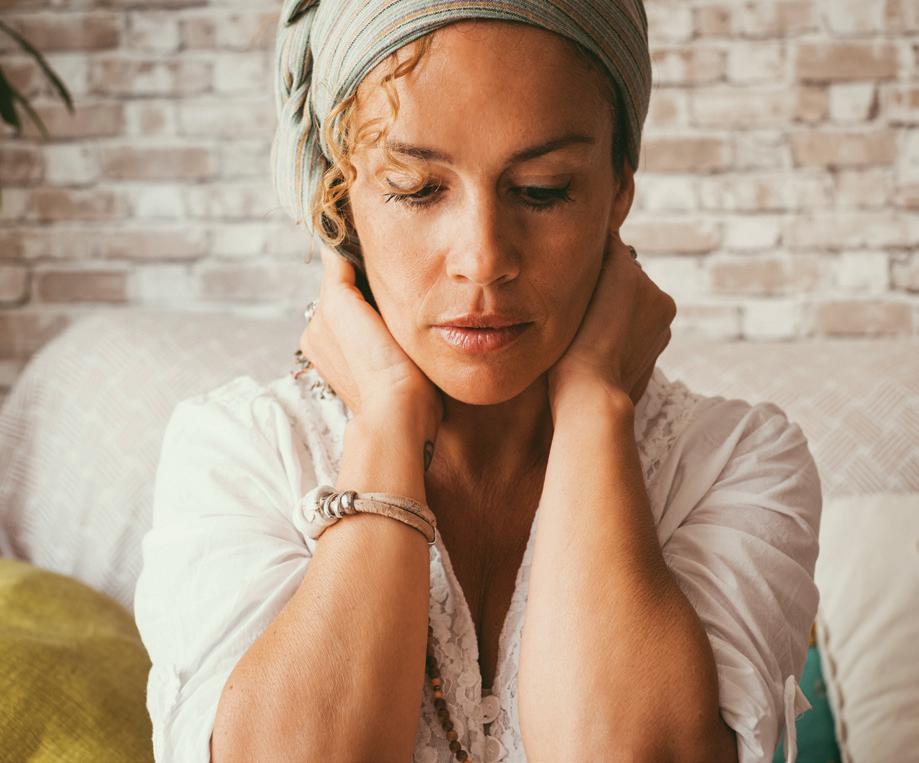
might experience some changes in your menstrual cycle, such as heavier or lighter periods, or more frequent or less frequent periods. Symptoms are typically most noticeable during the first few years of perimenopause, and may gradually become more intense as you approach menopause.
COMMON SYMPTOMS OF PERIMENOPAUSE AND MENOPAUSE
Everyone experiences perimenopause and menopause differently. While some women sail through this phase with minimal disruption to their lives, others may find the symptoms more challenging to manage. Common symptoms include:
Hot flushes and night sweats
These sudden feelings of warmth, often accompanied by sweating, are one of the most widely known symptoms of menopause. They can occur at any time of day but are particularly common at night, disrupting sleep.
Mood changes
Many women experience mood swings, irritability, or even bouts of anxiety and depression. These emotional shifts are primarily due to fluctuating hormone levels but can also be impacted by sleep disturbances and other physical symptoms.
Forgetfulness
Often referred to as “brain fog,” some women report difficulties with concentration, memory, or thinking clearly. This can be frustrating but is typically temporary and linked to hormonal changes.
Headaches
Hormonal fluctuations during
perimenopause can trigger new or more frequent headaches or migraines.
Sore breasts
Hormonal changes can lead to tender or swollen breasts, which can make everyday activities uncomfortable.
Aches and pains
Joint and muscle pain can increase during perimenopause, with some women experiencing stiffness, particularly in the mornings.
Dry vagina
As estrogen levels decrease, vaginal dryness and discomfort during sex are common. This can lead to an increased risk of urinary tract infections (UTIs) and vaginal infections as well.
Reduced sex drive
A decrease in estrogen can lead to reduced libido, which can affect relationships and intimacy.
Itchy skin
Decreased estrogen can also cause your skin to become drier and more prone to itching or irritation.
Weight gain
Metabolism tends to slow down as women approach menopause, which can contribute to weight gain, particularly around the abdomen.
Perimenopause and menopause are natural parts of a woman’s life, but the symptoms can sometimes be overwhelming. If you’re finding that the symptoms of perimenopause or menopause are impacting your quality of life, it’s important to speak with your doctor. Here are a few reasons why you might consider making an appointment:
Worried about your periods
If you notice significant changes in your menstrual cycle, such as very irregular periods, excessively heavy bleeding, or periods that last longer than usual, it’s a good idea to discuss these changes with your doctor to rule out other potential causes.
Symptoms are affecting your daily activities
If symptoms like hot flushes, mood changes, or sleep disturbances are preventing you from doing things you usually enjoy or need to do, your doctor can help you explore treatment options.
Impact on sleep, eating, or wellbeing If you’re struggling with insomnia, changes in appetite, or mood fluctuations that affect your eating, sleeping, and overall enjoyment of life, it’s important to talk to a healthcare professional who can offer solutions or treatments to alleviate these symptoms.
While menopause and perimenopause are natural processes, there are several ways to manage symptoms. Depending on the severity of your symptoms and your individual health needs, treatment options may include:
Hormone Replacement Therapy (HRT)
This is the most common treatment for severe menopause symptoms, as it helps replace the estrogen your body no longer produces. HRT can relieve symptoms like hot flushes, vaginal dryness, and mood swings, but it’s not suitable for everyone. A thorough discussion with your doctor can help determine if HRT is right for you.
Lifestyle changes
Diet and exercise play a key role in managing symptoms. Regular physical activity can help with weight management, reduce aches and pains, and improve mood. A healthy diet rich
in fruits, vegetables, and whole grains can also support overall wellbeing during this time.
Non–hormonal treatments For women who cannot or prefer not to take HRT, there are alternative options, including antidepressants, blood pressure medications, or other therapies to alleviate hot flushes, mood changes, and other symptoms.
Menopause and perimenopause mark a significant life transition, and while the symptoms can be challenging, there are numerous options to help you feel better. If you’re experiencing symptoms, don’t hesitate to reach out to your doctor. You don’t have to go through it alone, and together, we can find the right approach to help you navigate this stage of life with confidence and ease.
Dr Georgia Page enjoys all aspects of general practice and has been working at Your Family Doctors at Erina for the past 12 years. The practice has a fabulous team and they pride themselves on delivering good quality health care, with that special personal touch. For more information call 4365 4999, check the website www.yourfamilydoctors.com.au or like them on Facebook.
Resources – https://www.jeanhailes.org.au/health-a-z/menopause https://www.jeanhailes.org.au/resources/perimenopause-and-menopause-symptom-checklist

BY ZOE PAPADATOS, FOUNDER AND LEADING ACUPUNCTURIST OF COASTAL WELLNESS COTTAGE
In traditional cultures the skin is not merely a barrier to the external world but a dynamic reflection of internal health. Unlike modern dermatology, which often focuses on treating skin concerns at the surface level, traditional cultures views the skin as a window into the body’s overall wellbeing. Changes in skin texture, colour, and condition as well as breakouts in these specific areas are seen as indicators of deeper imbalances within organs, blood circulation, and energy (Qi) flow. A method called Facial Mapping is a diagnostic technique in traditional Chinese medicine, providing insight into internal disharmonies that alter skin appearance.
What could face mapping tell us about your skin and overall health?
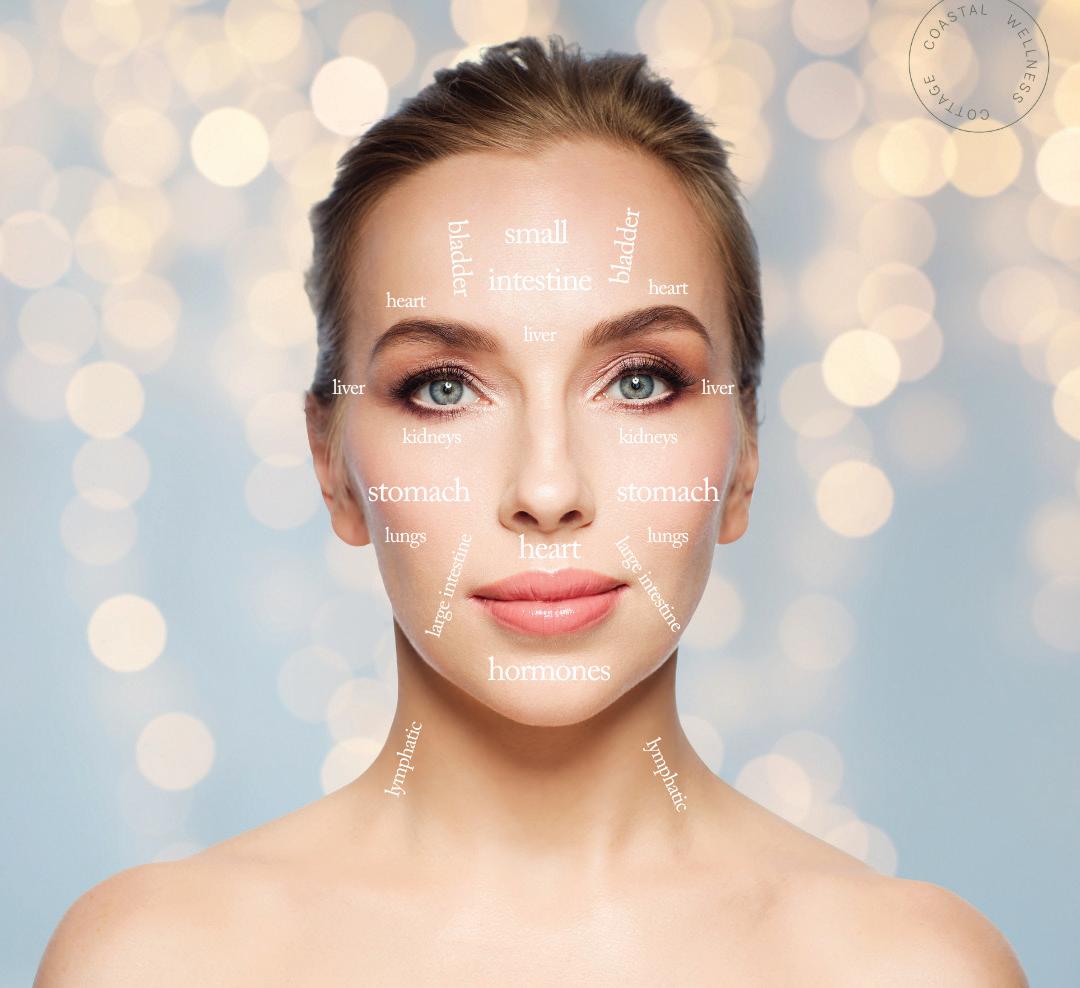
Related systems: digestive and nervous system
Common issues: bloating, indigestion, stress, poor sleep
Traditional insight: breakouts or redness here may suggest an overworked digestive system, often caused by excessive consumption of processed foods, sugar, or alcohol. It may also indicate high stress and poor sleep habits.
Solutions: improve digestion by eating warm, cooked foods, drinking herbal teas like ginger, peppermint or camomile, and practicing stress relief techniques such as meditation and mindfulness.
BETWEEN THE EYEBROWS
Related systems: liver, detoxification
and nervous system
Common issues: anger, toxicity build–up, high stress
Traditional insight: the liver is responsible for detoxification and the smooth flow of energy in traditional medicine. A congested liver, due to alcohol, heavy foods, or unexpressed emotions, may cause breakouts, deep lines, or redness in this area.
Solutions: reduce alcohol and fried foods, incorporate bitter greens (like dandelion and kale), and practice deep breathing exercise.
TEMPLES AND AROUND THE EYES
Related system: adrenals
Common issues: fatigue, dehydration, poor detoxification
Traditional insight: the kidneys store

Unlike modern dermatology, which often focuses on treating skin concerns at the surface level, traditional cultures views the skin as a window into the body’s overall wellbeing
essence (Jing), which influences vitality and ageing. Dark circles, puffiness, or fine lines may indicate dehydration, kidney weakness, or adrenal fatigue from overwork and stress or nutritional deficiencies.
Solutions: hydrate well, avoid excessive caffeine, consume warm and wholesome foods and get adequate rest to nourish adrenal energy.
Related system: circulatory system and emotional health
Common issues: emotional and mental health, stress, blood pressure
Traditional insight: redness or swelling on the nose may indicate cardiovascular stress. Persistent redness may be a sign of excessive heat in the heart, often due to
emotional stress or an unbalanced diet.
Solutions: engage in regular cardiovascular exercise, consume heart–healthy foods like omega–3 rich fish and walnuts, and practice relaxation techniques.
Related system: respiratory and digestive system/immune health
Common issues: respiratory allergies, poor digestion, skin sensitivity, poor immunity
Traditional insight: the lungs control skin health, so acne, dryness, or irritation here may suggest lung Qi deficiency or respiratory sensitivity. Redness or rosacea–like symptoms can also point to stomach inflammation.
Solutions: avoid dairy and excessive spicy foods, practice deep breathing exercises, and consider herbs like licorice root or astragalus to support lung health.
Related systems: endocrine and nervous system, reproductive organs
Common issues: hormonal imbalances, menstrual irregularities, stress–related breakouts
Traditional insight: breakouts around the chin and jawline are often linked to hormonal fluctuations and imbalances. In women, this area is associated with the reproductive
organs, and imbalances may be related to menstrual cycles, PCOS, or stress.
Solutions: maintain hormonal balance with a nutrient–dense diet focusing on protein and fresh fruit and vegetables, regulate sleep cycles, nervous system calming and herbal medicine and acupuncture.
JAWLINE AND NECK
Related System: lymphatic system, detoxification
Common Issues: poor detoxification, water retention, sluggish circulation
Traditional Insight: swelling, breakouts, or puffiness in this area can signal a sluggish lymphatic system struggling to remove toxins efficiently.
Solutions: stimulate lymphatic drainage through gua sha or facial massage, drink plenty of water, saunas and incorporate detoxifying foods like leafy greens and citrus fruits.
If you notice persistent skin issues, consider consulting a licensed practitioner who can provide a more personalised assessment and holistic treatment plan tailored to your unique constitution. Your face truly is a reflection of our internal health so it is time to tune it and listen to what it is telling you.
This article is for informational purposes only and is not intended as medical advice.

BY SELINA CHAPMAN, PSYCHOLOGIST

When I found out I was pregnant with twins it was like winning the lottery. I was an older first–time mother. I had hoped for a two–for–one special and couldn’t believe my luck when it came true.
Despite my initial joy, a twin pregnancy, especially when it is within the ‘geriatric’ maternal age, does come with added risks and complications. There are increased risks associated with carrying any pregnancy in an older body, stretch marks withstanding, such as maternal gestational diabetes, post natal anxiety and/or depression and a greater risk of a chromosomal disorder.
Every pregnancy and parenting experience is unique and one’s own journey. This article is about connecting with prospective and existing parents of multiples, to encourage and support
accessing mental health supports and resources along the way.
According to the Australian Multiple Birth Association’s (AMBA) report published in March 2024, “Multiples Unfiltered. The untold stories of Australian mothers surviving the early years with multiples”; of all pregnancies in Australia 1.4% result in a multiple pregnancy of which 98% are twins and 2% are triplets or higher order multiples.
Twin Research Australia reports the rate of “twinning” is about 1 in 80 pregnancies, so 1 in every 40 Australians are a twin. Some famous twins include Lisa and Jessica Origliasso also known as The Veronicas, Ashton Kutcher, and Scarlett Johansson.
Did you know that there are more than two types of twins? We are more familiar with identical (monozygotic or one egg) and fraternal (dizygotic or two egg) twins however there are also
conjoined twins, mirror image twins and chimera twins. How twins develop in the womb also dictate variants on the type of twin they are. Another interesting fact is that identical twins are not 100% genetically the same, and their genetic similarity percentage can vary between monozygotic twins.
I acknowledge that not all twin or higher order births are welcomed and even if they are, it can come as quite a shock. We question what we are capable of, if we can meet the challenges ahead. Rates of post natal anxiety and depression for all parents (including males) increases with multiples. Taking care of our mental wellbeing before and after pregnancy is very important.
The needs of prospective parents, medically and holistically, are going to be different so specialised support from medical and allied health professionals are highly recommended to get that tailored and appropriate pre–natal and

post natal care for all parents. This can include pre natal classes, books to read, sleep support, childcare or parenting support. It is important to say yes to helpful offers, know your limits and to reach out when you need it.
The most important piece of information that I wish to share is that we can all learn to be a parent of multiples and work it out in a way that suits your family. Yes, it is challenging, rewarding, difficult, enjoyable, chaotic and beautiful, and achievable.
Some challenges that a lot of multiple parents face is that our world becomes more isolated than with singletons. Many days I would be stuck at home, too tired to leave or repack nappy bags and change clothes and feed two babies again so I would give up and stay at home. Sometimes friends stop calling to “not bother” or “wake the babies”, which adds to feelings of isolation and loneliness.
The twin experiences of each other
are special and different from singletons. There is a bond that needs to be considered for individual and collective wellbeing. For example, when all else failed, and I couldn’t settle one of the babies, I would put them together and it was their twin that charmed them into sleep or a state of calm.
I had my own personal fears and concerns like getting them mixed up, not being able to breastfeed, listening to other people’s opinions and comments and not trusting my support system and my own instincts.
At these moments this is when you might want the shared or lived experience from other parents and/or professionals.
For psychological wellbeing, the most successful approach is one that is flexible and responsive to any expectations to how you want to raise your multiples. You do what you can, when you can. Sometimes this means making do or
changing what is needed to make life easier and more practical. We all make mistakes, and we can learn, adapt and thrive.
Personally, I feel lucky to be in the Twin Club with all its hardships and joys. My twins have a playmate (or frenemy) for life and watching them grow together is beautiful.
For helpful resources please visit: Australian Multiple Birth Association www.amba.org.au
Twin Research Australia www.twins.org.au
Perinatal Anxiety and Depression Australia www.panda.org.au
Loss of a baby in a multiple pregnancy www.neonatalbutterflyproject.org
Selina Chapman is a mum of twin boys and a psychologist at The Hearts and Mind Collective in Wyoming. She works with individuals of all ages seeking empowerment and support. Selina says, “Seeking support for mental health is about maintaining emotional and mental wellbeing as well as having extra help as and when we need it”.

BY LOUISE HURLEY, MumSafe TM TRAINER OF THE YEAR 2022
Do you find push ups hard to do? I’m going to let you in on a little secret… that’s because they are hard! Lot’s of women say that they are unable to do push ups, but in my experience as a fitness professional who predominantly works with mums, that’s because they miss the crucial foundational steps to building push up strength. The trick is to nail the basics then steadily progress from there, getting stronger as you go instead of always opting for doing mini push ups on your knees. Although my focus is on mums, the principles and techniques discussed here can benefit anyone aiming to get their first push up or increase repetitions and boost overall muscle and joint strength.
Push ups are a compound movement, meaning it works multiple muscle groups at once, which helps in building overall muscle strength and joint stability – key factors that support daily activities like lifting, carrying, and playing with your children. As women approach menopause and our bodies transition through this change, declining estrogen levels contribute to muscle loss and a decrease in bone density and joint strength. Big movements such as push ups can help maintain strong muscles, joints and bones.
Push ups primarily target the chest, shoulders, and triceps, but also engage your core, back, and even legs, so you really get the most bang for your buck with this exercise! So, ready to get started?
1. Start with wall push ups
For beginners or those needing to manage intra–abdominal pressure (if you’ve recently been pregnant, for example), wall push ups are a fantastic starting point. Stand a few feet away from a sturdy wall, place your hands on the wall at shoulder height, and perform a push up motion by bending your elbows. Exhale as you push away from the wall. This modification reduces the load on your core and is a great starting
point. If you can do ten of these, try the next level.
2. Progress to incline push ups
Once you’re comfortable with wall push ups, the next step is an incline push up. Use a bench or a sturdy table, positioning your hands on the elevated surface while the balls of your feet remain on the ground. This step increases the intensity slightly while still reducing the demand on your core compared to a standard push up. Aim to get your chest down to the same level as your hands and exhale as you push away, looking straight ahead. If you can do ten of these well with good control and getting your chest down to the surface that your hands are on, try doing them on an even lower surface or try the next level.
3. Try the first phase of the push up on your toes
Start in a plank position with your hands slightly wider than shoulder width apart. Slowly lower your body, keeping your elbows close to your torso, until your chest touches the floor. Your chest should touch the floor before your hips. This is called the eccentric phase of the movement. Then keep your knees on the floor as you push back up from the ground (the concentric phase). Essentially you are doing half a push up on your toes and then the other half on your knees. This is a great way to strengthen your chest muscles and build stability. When you can do at least five of these, have a go at full push ups.
4. Transition to the standard push up
Start as you did in the last step, but this time you’re going to try to push back up to the starting position with your knees off the floor, maintaining a strong and stable core throughout the movement. If you can do one, then great! Build up to two. Already got two in the bag? Awesome. Build up to three (and so on).
FOR PREGNANT WOMEN AND WOMEN WITH ABDOMINAL SEPARATION OR PELVIC ORGAN PROLAPSE
For women who are pregnant or
Push ups are a compound movement, meaning it works multiple muscle groups at once, which helps in building overall muscle strength and joint stability – key factors that support daily activities like lifting, carrying, and playing with your children
experiencing conditions such as diastasis recti (abdominal separation) or pelvic organ prolapse, it’s crucial to modify exercises to decrease intra–abdominal pressure. Here are some tips to help you keep your push ups in routine:
1. Use supported surfaces Opt for wall push ups or incline push ups as your primary exercises. These modifications reduce the load through the abdominal wall whilst still allowing you to maintain strength. For many pregnant women or those with diastasis recti or pelvic organ prolapse, these variations provide a more effective way to work on upper body strength while minimising pressure through abdominal connective tissue and pelvic floor.
2. Engage your pelvic floor and deep core
Before you begin a push up, take a moment to gently engage your pelvic floor muscles and begin the exhale. You can also imagine that you are trying to draw your hip bones closer together as you exhale (this can help you engage your deep core). This subtle activation can provide additional support and reduce the risk of further strain. Before adding in pelvic floor exercises to your routine I highly recommend seeing a pelvic health physiotherapist.
BY JACQUI BILSON, PRINCIPAL SOLICITOR AT BILSON LAW
Ensuring your children’s future! As the New Year begins, it is a good opportunity to reflect and plan for the future. When making your resolutions, take time to consider estate planning to protect your family’s future and wellbeing.
A Will is the cornerstone of any estate plan, outlining your wishes regarding asset distribution and the care of your minor children. This article delves into essential considerations for arranging care for minor children in a Will, providing you with the knowledge to secure their future.
KEY COMPONENTS FOR ARRANGING CARE FOR MINOR CHILDREN IN A WILL Guardianship
One of the most important decisions in your Will is naming a guardian for your minor children. This person will care for and raise your children if you are no longer able to do so. Choose someone you trust implicitly and who shares your values.
Trusts
Establishing a trust in your Will can provide financial security for your children. A trust allows you to specify how and when the assets will be distributed, ensuring their financial needs are met throughout their upbringing and into adulthood.
STEPS TO MAKE ARRANGEMENTS FOR MINOR CHILDREN IN YOUR WILL
1. List your assets and goals
Begin by listing all your assets, including real estate, bank accounts, investments, life insurance policies, and property. This will help you understand the scope of your estate. Next, consider your goals for your children, like providing for their education, healthcare, or future housing. Clear goals will guide asset distribution to benefit your children.
2. Nominate a guardian
Select a guardian for your minor children who you trust. Discuss your decision with the potential guardian before drafting your Will and appoint a substitute if your chosen guardian cannot act.
3. Establish trusts
Establishing a trust in your Will can provide financial support for your children into adulthood. The trust can specify how and at what age the funds will be distributed to ensure your children’s needs are met at different stages of their lives.
4. Make a statutory declaration
Make a statutory declaration supporting your decisions in the Will, particularly regarding the guardianship of minor children. This provides additional legal support and clarity to your wishes.
5. Review and update your will regularly
Your Will should be an organic document that evolves with your circumstances. Review and update it regularly, especially after major life events such as marriage, divorce, the birth of a child, or acquiring significant assets.
GUARDIANSHIP APPOINTMENT IN THE ABSENCE OF A WILL
If both parents of minor children are deceased and no guardian is appointed under a valid Will, guardianship decisions fall to the Supreme Court or Family Court. Individuals with an appropriate relationship with the children, such as grandparents, aunts, uncles, siblings, or family friends, can apply for guardianship. The Court evaluates applications and decides based on the children’s best interests who is the most suitable guardian. To ensure your children are cared for by someone you trust, it is advisable to appoint a guardian through a valid Will.
To best protect the wellbeing of your minor children, it is important to understand the enforceability of guardianship arrangements in a Will. This ensures that, if you pass, your children are cared for according to your wishes, even if the children’s other parent survives.
Disputes and family court applications If the surviving parent opposes the appointed guardian’s involvement, the guardian can seek the Family Court’s intervention. The court will consider factors such as the relationship between the children and guardian, the surviving parent’s reasons for objection, and most importantly, the children’s best interests. It is, therefore, critical to prepare and collate relevant information about your preferred guardianship appointees and store them with your Will.
Making arrangements for your minor children in your Will is a vital step in securing their future and providing peace of mind. By creating a comprehensive Will, you can ensure that your children are protected and have peace of mind knowing that your children will be cared for by someone you trust, even in unforeseen circumstances.
By following the steps outlined in this article and seeking professional guidance, you can create a Will that reflects your values and meets your family’s needs. Here’s to a prosperous and well planned future!
For more information, contact the Bilson Law team Phone (02) 4339 0999
Suite 4, 210 The Entrance Rd Erina NSW Australia 2250
bilsonlaw
bilsonlaw.com.au
BY ALITA BLANCHARD, HOLISTIC COUNSELLOR AND PARENT COACH
Parenting brings up many intense feelings, a fierce protectiveness of our children and plenty of joy.
And it can also awaken anger, crippling perfectionism, fear, and a need for control. Many parents, especially mothers in the early years, find themselves wrestling with emotions they didn’t expect. You might fear your own anger, struggle with losing control, feel shame when you don’t “get it right,” or battle the exhaustion of perfectionism. Maybe frustration and rage take you by surprise, leaving you wondering, Where did that come from?
Parenting often unearths everything unresolved in us. And while that can feel overwhelming, it’s also an invitation to grow.
UNDERSTANDING THE ROOTS OF THESE STRUGGLES
1. Fear of anger and rage
Many parents fear their own anger, especially if they were raised in homes where emotions weren’t safe. You might suppress it until it erupts or feel guilt for even having it. But anger itself isn’t the problem – it’s a signal. When you learn
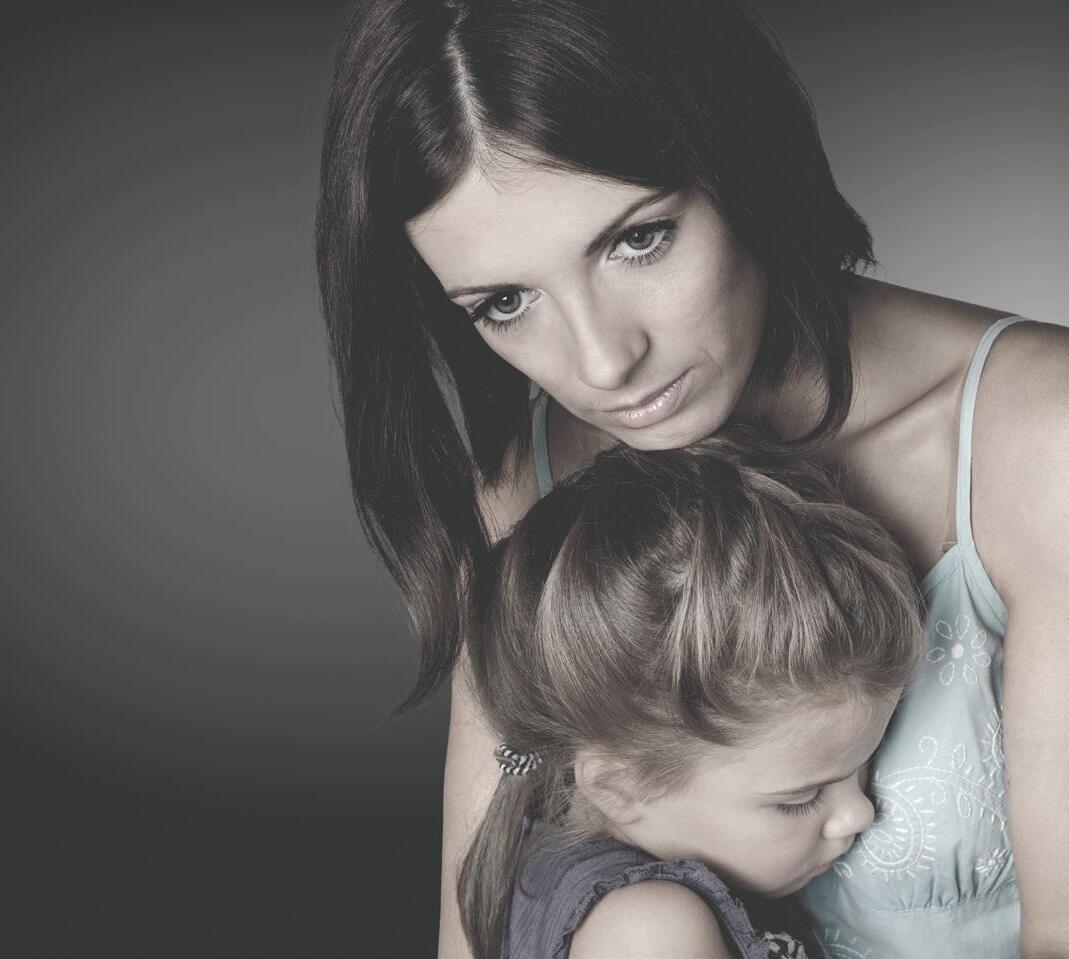
to work with it, rather than fear it, you can access its wisdom and set boundaries without regret. The goal isn’t to never feel these emotions but to learn how to move through them with more ease.
2. The need for control
New mothers often feel an urgent need to control everything – schedules, behaviour, emotions because unpredictability feels unsafe. But control is an illusion. The more we try to grip tightly, the more stress builds. Learning to trust yourself and your child is a slow but freeing process.
3. Shame and perfectionism
The pressure to be a “good mother” can be crushing. If you grew up equating mistakes with failure, parenting can trigger deep guilt and shame when things go wrong. But mistakes are part of learning – for both you and your child. Learning how to repair after tough moments is so much more valuable that trying to be perfect.

Parenting often unearths everything unresolved in us. And while that can feel overwhelming, it’s also an invitation to grow
WHERE TO START: SMALL DAILY SHIFTS
Healing these patterns isn’t about a single breakthrough—it’s about daily micro–moments that retrain your brain, body, and nervous system over time. Here’s how to begin:
1. Ground yourself before reacting
Practice taking a conscious breath and long slow exhale before responding.
Place a hand on your heart or belly to reconnect to your body.
If you feel triggered, step outside or move your body to release tension.
2. Create a pause practice
Instead of reacting immediately, take three slow breaths.
Say in your mind or out loud “This is not an emergency”.
This small space between trigger and response helps rewire your reactions.
3. Name what’s happening
When anger rises, say, “I feel overwhelmed right now, but I am safe.”
Naming emotions out loud softens their intensity.
4. Let go of perfectionism
Remind yourself: “My child doesn’t need a perfect parent – good enough is good enough.”
When mistakes happen, focus on repair rather than self–criticism.
5. Build tiny moments of regulation
Step outside for two minutes of fresh air. Look at the sky. Notice clouds.
A gentle neck stretch and massage your ears to release tension.
Rinse your hands in cold water to reset your nervous system.
Take one mindful sip of tea or water. Icy cold water can be regulating.
SOMATIC PRACTICES TO SUPPORT EMOTIONAL REGULATION
When emotions feel overwhelming, working with your body can help:
Shake it off: If frustration builds, shake your hands or legs to release tension.
Humming or sighing: These activate the vagus nerve, shifting your body toward regulation or “calm”.
Weighted sensation: Holding a warm drink, wrapping in a blanket, or placing a hand on your chest can be deeply soothing.
Slow exhale breathing: Inhale for four counts, exhale for six. This tells your nervous system, You are safe.
RETRAINING THE BRAIN: SMALL MINDSET SHIFTS
Our thoughts shape our emotional landscape. These simple reframes can help:
Instead of I’m failing at this, try, “I’m learning something new.”
Instead of I have to do it all, try, “It’s okay to ask for help.”
Instead of I shouldn’t feel this way, try “My feelings are valid, and I can move through them.”
TAKES TIME AND THAT’S OKAY
Parenting will challenge and stretch you. There will be days when you feel like you’re getting it right and days when you don’t. Growth isn’t linear – it’s messy, layered, and ongoing.
But each time you pause, breathe, and respond with more softness, you’re creating change. Each time you let go of control and trust yourself, you’re healing. And each time you show up with love, even in the messiness, you are enough.
Because the truth is, parenting isn’t about being perfect. It’s about being present. And that is more than enough.
Visit theawaremama.com.au and sign up to Aware Mama news to a free eBook on Radical Self Care tips and a copy of PRACTICE THE PAUSE to print out for your fridge or wall
Alita Blanchard, The Aware Mama, based on the NSW Central Coast, Alita is a mother of 4 boys, Holistic Counsellor, Nervous system informed Parent Coach and Emotional Release practitioner. She holds mothers circles, online programs and offers 1;1 counselling and support online for overwhelmed parents. Instagram: @alitablanchard_ Email hello@theawaremama.com.au www.theawaremama.com.au Remind yourself: My child doesn’t need a
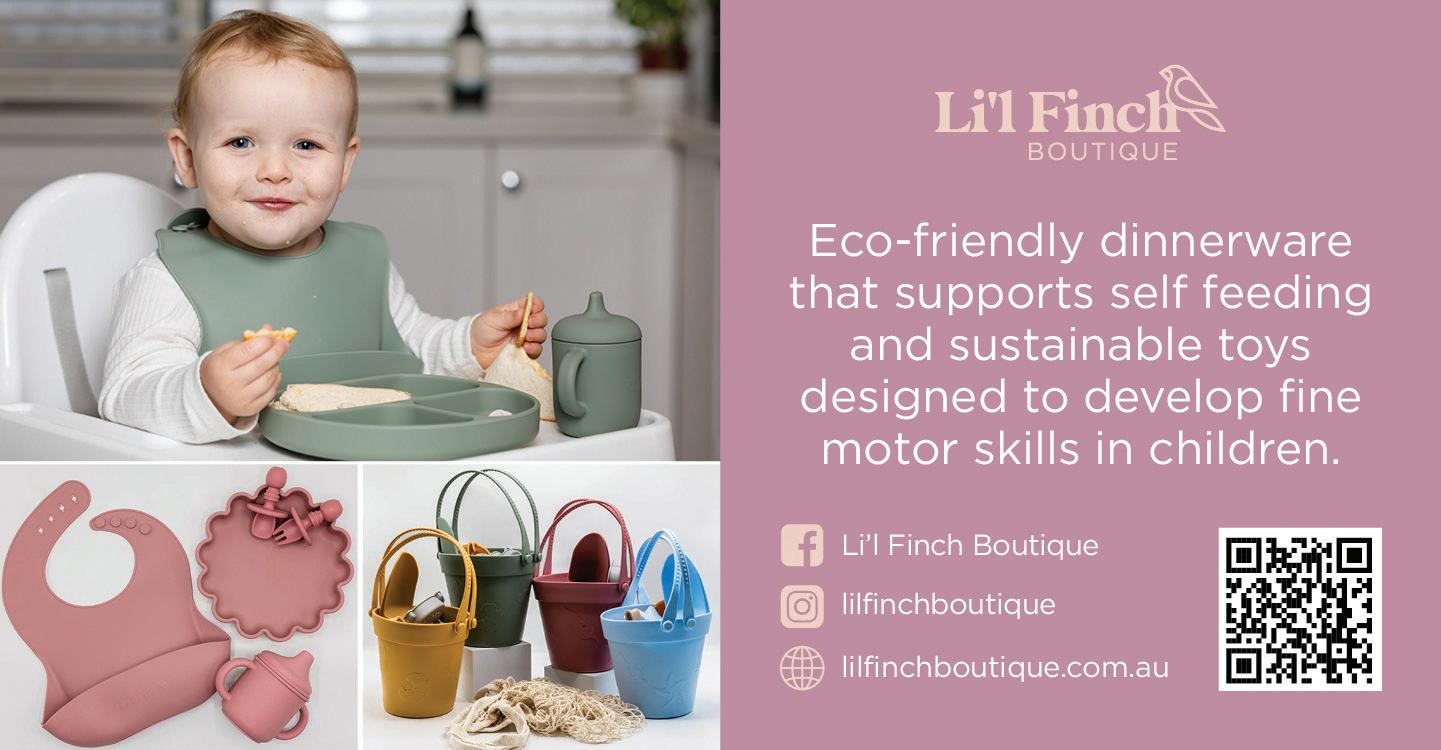

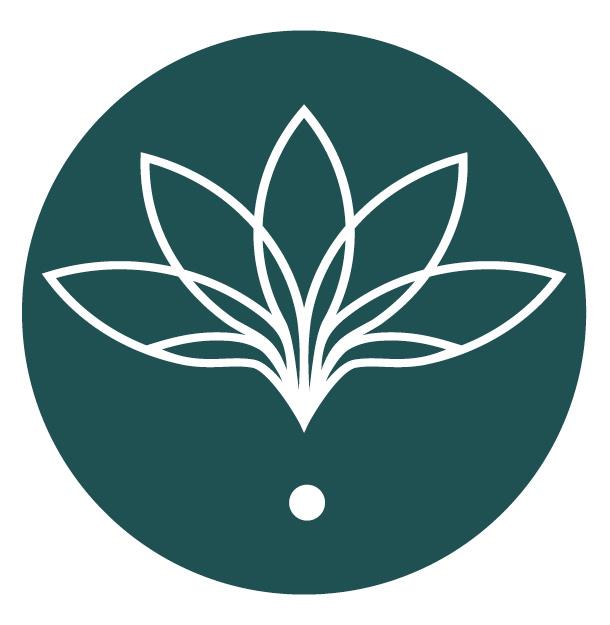
BY CARIN CLEGG, ACCREDITED PRACTISING DIETITIAN AND FITNESS PROFESSIONAL
We all have one body in this life and we need to learn how to look after it to enjoy a fulfilling life for as long as we are on this Earth. But, our modern busy lives, full of screens and many networks of people, can make us forget about what we need to do to look after our body. Here are a few tips to help you rethink how you love your body.
We all come in different shapes and sizes. No one is ‘perfect.’ There is no such thing as the thin ideal, this is something the media and old misled science has sold us. In fact, the BMI was created for population studies, not for individual use. Men and women have different body builds and our bodies change at every age and stage of life, so using one BMI number for both genders does not make sense. Also the standard BMI measurement does not apply for growing bodies.
We now know all the focus on weight, makes people less happy, it increases poor eating habits, reduces body satisfaction, and increases the risk of eating disorders. We need to take the subject of weight off the table.
We all need to embrace our bodies and love ourselves more. Remove the scales from your house and focus on all the things you do like about your body and all the things your body can do.
A good sleeping habit sets the foundations for good eating habits and physical fitness.
Sleep is so important to how we feel and how our mind and body functions. Sleep recharges your energy levels, heals, helps to build muscle, as well as influences hormones, hunger, how active we can be and our food choices.
Create a love for sleep in your household. Prioritise it. Ensure everyone has a good sleep routine. Make bedtime the same time every night. For the half hour prior to bed plan some relaxing activities, dim the lights, and avoid screens to wind down both mind and body.
Our bodies are designed to move. They have evolved to run long distances to hunt down prey. Compare this to our modern life. How different were our bodies back then, stronger, fitter, with a longer endurance. It is no wonder our bodies feel sick, lacking energy when we are so sedentary.
Think of exercise or body movement as medicine. In fact, for many mental health conditions, exercise prescription is far more effective than any medicine.
Exercise makes us more able to cope with any stress that comes into our life, improves our mood, gives us energy, encourages a good appetite, and helps us sleep well. The mind–body connection builds confidence, self–satisfaction, a positive body image and inevitably makes you love yourself.
Make exercise fun. We all deserve and need to prioritise having fun in our lives no matter our age. Go for a daily walk, run, swim or bike ride, kick or bat a ball around or perhaps try something new like a dance or circus class. Whatever you choose, make sure you find enjoyment in it, as this is the secret to being fit and healthy for years to come.
Eating the foods our body needs, means our body gets the right amount of nutrients to function optimally. Good digestion, a strong immune system, feeling energised and strong as well as keeping all those medical markers of disease at bay. However, nourishing your body with food can be so much more.
Slow down and eat mindfully and purposefully. Think to yourself, eating is a way you love your body, a guaranteed way you nourish the body. Savour all the smells, tastes, and textures as you eat. Be aware of how the food makes you feel, emotionally and from a hunger and satiety aspect.
Putting the effort in to grow your own food and being able to eat it is so rewarding. Cooking, when you give yourself the time, can be a fabulous creative outlet for the soul. Combining the two, growing food, cooking, and sharing meals together builds that nutritious connection with your body, food and the people close to you in your life and is the ultimate form of nourishment.
Embrace and love your body in all the ways you can and encourage everyone else in your world to do the same to feel happy, healthy and vibrant!
Carin Clegg is the Director of Bright Diets, is a Paediatric Dietitian and Fitness Professional with an interest in sustainability. Carin wants everyone to be clever about their eating to feel happy, healthy and vibrant! Reach out at 0413 77 44 11, www.brightdiets.com.au or on the socials.

